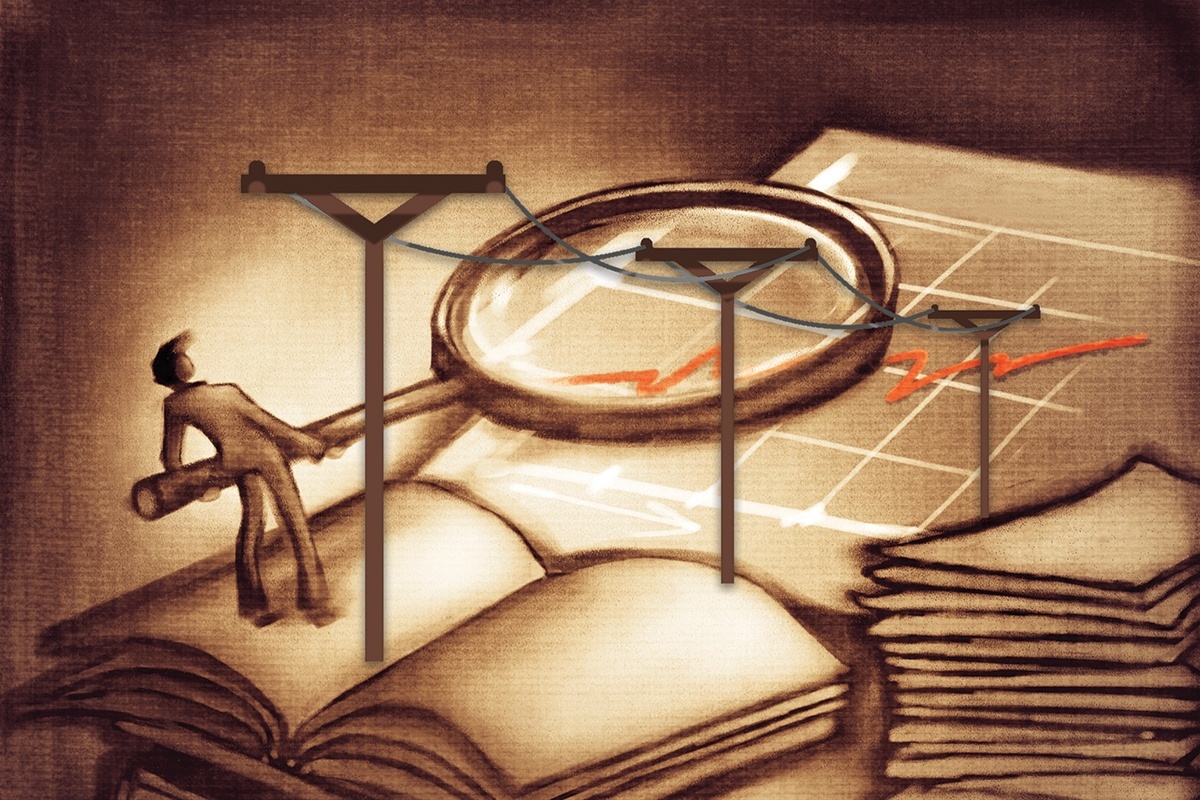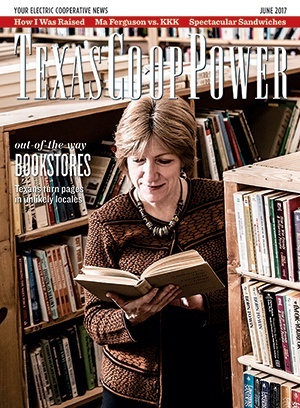The time has come to spill the beans—the same ones United’s dedicated professionals account for, expertly, every day.
It takes a lot of financial wherewithal and fiduciary oversight to bring power daily to United’s nearly 60,000 members.
And while accounting and finance will likely never dent the Top-10 List of most craved discussion topics for most folks, United members can benefit from a quick tour through the economic landscape of electric cooperatives—United in particular.
To abbreviate the findings of auditors who annually pore through and grade United’s inventories and financial accountings, one old-fashioned British adjective might best describe their customary appraisal of the cooperative’s fiscal health, “capital.”
In a nutshell, it is United’s business and fiscal acumen that underpins every endeavor, every facet of the cooperative’s day-to-day operation and its continuing regard as one of the most-efficient and productive electric cooperatives in the state and nation.
When all the numbers are crunched, the electric distribution utility industry certainly qualifies as one of many that are capital intensive, which means that it is an industry whose major costs result from investments in plant infrastructure or other expensive capital assets that are needed to produce a good or service—resources that give a company, such as an electric cooperative, its legs.
By their nature, electric cooperatives were begun by the very people who would buy electricity their cooperatives delivered—an answer to a plight they endured then as country folk who never expected to receive electric power from aloof urban delivery systems.
Just as they did when they first were formed by rural Americans near the outset of the Great Depression in the late 1930s, rural electric distribution cooperatives like United today rely heavily on lending resources that are designed to accommodate a cooperative’s immense outlay of material resources, as well as its singular not-for-profit business model and operation. Initial government funding provided through the Rural Electrification Act of 1936 provided low- interest federal loans for the installation of electrical distribution systems that would serve isolated rural areas of the nation that for-profit utilities had no interest in serving.
Then, as now, such loans allowed cooperatives and their members to service debt levels for long terms.
Balanced Funding of Utility Plant
Since large investments are made in capital assets (electric distribution plant), with returns on investment spread the lifetime of the assets, utility plant funding is an ongoing challenge. For example, United’s cost for extension and replacement of utility plant alone was $23 million in 2016. And by year’s end, the cooperative’s total utility plant of $355 million represented 90 percent of its $392 million in assets.
In total utility plant —utility poles, transformers, conductor and other myriad material that constitute a modern electric distribution system—United has a collective investment of nearly $34,000 in every mile of energized power line that crisscrosses its 14-county service territory (a 10,500-mile stretch that would take you from Fort Worth and across the Pacific ocean to the west coast of Australia.
USDA To Fund $90.48M United Upgrade
United Cooperative Services General Manager and Chief Executive Officer Cameron Smallwood said that because of the primary importance of the cooperative’s distribution system described above, United engineering and planning departments constantly monitor critical aspects of the system using predictive models to forecast future plant improvements. The latest four-year plan assessment model includes $90.48 million in new construction and improvements for 834 miles of line and other electric service system improvements.
”We begin the planning process every four years by estimating the funds we will need for service to new members who will be added to our system, and for upgrades across our growing service areas,” Smallwood said.
Loans administered through the U.S. Agriculture Department Rural Utilities Service (RUS) figured prominently in United’s ability to fund the most recent four-year plan. That lending was a small part of the U.S. Department of Agriculture’s lending portfolio. For example, the agency announced in October 2016 that $3.6 billion in loans will be used to fund 82 electric projects in 31 states.
“For 80 years, rural electric utilities have provided reliable and affordable electricity to help rural communities increase productivity and build stronger economies,” former U.S. Agriculture Secretary Tom Vilsack said. “These loans will help them continue to do that. The utilities and cooperatives will use some of the money to finance energy efficiency projects, renewable fuel systems and smart grid technologies to increase our energy independence and improve rural electric infrastructure.”
Long-term Planning
Electric rates and long-term debt are the two primary sources of funding United’s utility plant. Rather than fully funding each year’s cost of extending and replacing utility plant through rates, principal and interest on long-term debt is a cost borne by members on an annual basis; this allows members that are using the utility system to pay their fair share of the cost. Such consideration is based on the philosophy that it would be unfair to have a member that may be on United’s utility system for a few years front the full cost for utility plant that will last 30 years.
“Overall, our philosophy has always been to consider and weigh the membership’s position—we have to respect that our members may have a better use for their money today than investing in assets they will never use ,” United Chief Financial Officer Lynn Godfrey said. “Yet, despite being a not-for-profit business, we have to make a responsible margin to continue operations and maintenance of plant and plant expansion. Therefore, there is a portion of every member’s bill that goes into the long-term investment of the cooperative. It’s a balance that we continually consider.”
Viewing interest costs as another necessary utility plant cost component (separate, but similar to material or labor) in order to get a return on the investment over many years is a key characteristic of a capital intensive industry. In that vein, United has made managing of the cost of financing a priority. As a result, the cooperative has been able to reduce the blended interest rate of its mortgage notes from 5.2 percent in 2010 to 3.6 percent in 2016, which represents millions of dollars in savings.
Competitive Rates
By their design, cooperatives don’t serve distant investors, but rather member-owners, a consumer-centric purpose that generally predisposes cooperatives to be rate-sensitive rather than profit-motivated. In that regard, the 2000 consolidation of Johnson County and Erath County electric cooperatives into what today is United created substantial economies of scale and operational efficiencies that benefit our member-owners. This foresight by the board of directors, along with the support of members from both electric cooperatives, helped United insulate members against any distribution rate increases from 2003 to 2015. During that same period, United also increased its equity ratio from 49 percent in 2003 to 54 percent at the end of 2016. Even with a minimal 4 percent rate adjustment recently implemented in two stages in 2015-2016, the cooperative has been able to maintain competitive rates.
Benchmarking
Like all businesses, cooperatives rely largely on consumer growth to help spread the costs of their service delivery and rising capital costs. The industry gauge for healthy annual meter growth is typically pegged at 2 percent or more, but unlike other businesses, electric utility companies are often subject to growth that gravitates within service boundaries defined by the state’s public utility commission. In other words, meter growth has a lot to do with where consumer migration makes a new home—retail, commercial and industrial. Even though United has been experiencing rapid growth in Johnson and Hood counties, the cooperative still serves areas that are mostly rural and less densely populated.
Nevertheless, United has focused on the factors it can control in bringing extra service value to its members. While 70-80 percent of a member’s monthly electric bill is attributed to the pass-through wholesale power cost United pays to Brazos Electric Power Cooperative, remaining costs always fall under the scrutiny of the cooperative’s value focus.
As a primary initiative, United strives to be as efficient as possible in the operation and maintenance of is distribution system, member assistance, billing and administration. These “controllable costs” are evaluated constantly and compared to those of other like-sized electric cooperatives in the nation and United’s ratio of controllable costs per meter has ranked among the top 10 percent most efficient since 2008—which translates to millions of dollars in savings—when compared to like-sized electric distribution cooperatives nationwide.
Additionally, benchmarking can also signal areas where improvements can be made. As an example, the cooperative is currently studying the viability of new procedures for maintaining its rights-of-way—vegetation management that can clear interference with electric service. New procedures developed as a result of the study may initially increase costs to United for several years, but the long-term benefits of the new measures will reduce the aggregate cost over many years and improve electric service reliability.
A Successful Business Model
United has been successful in the electric distribution service industry with its business model. Some cooperatives throughout the nation have elected to diversify to meet the needs of members and form new subsidiaries such as gas and water companies, cable companies and even retail stores.
“While United will always focus on meeting the electric service needs of our members and the challenges of operating an electric cooperative, we do watch what works and does not work at other cooperatives.” Vice President of Accounting and Finance Russell Young said. “Until the needs of our members warrant a change, we will focus our efforts on being exceptional as an electric distribution system, though we foresee changes within the electric distribution system as alternative power sources expand. We will apply the same value principles that have made us successful in the past in whatever service roles we play in the future for our members.”
Sharing in the Success
The success of what began with the Rural Electrification Act of 1936 continues today. Just a glimpse into the economics of United will show that short-term decisions have long-term effects. The cooperative shares the success of decisions made in prior years with those members who have invested in United’s future. For example, United has returned more than $80 million in member dividends (also referred to as capital credits) to present and former cooperative members—bottom line, a result of United acting on the principle that all financial decisions should be member-focused, and that all cooperative assets are member-owned.


